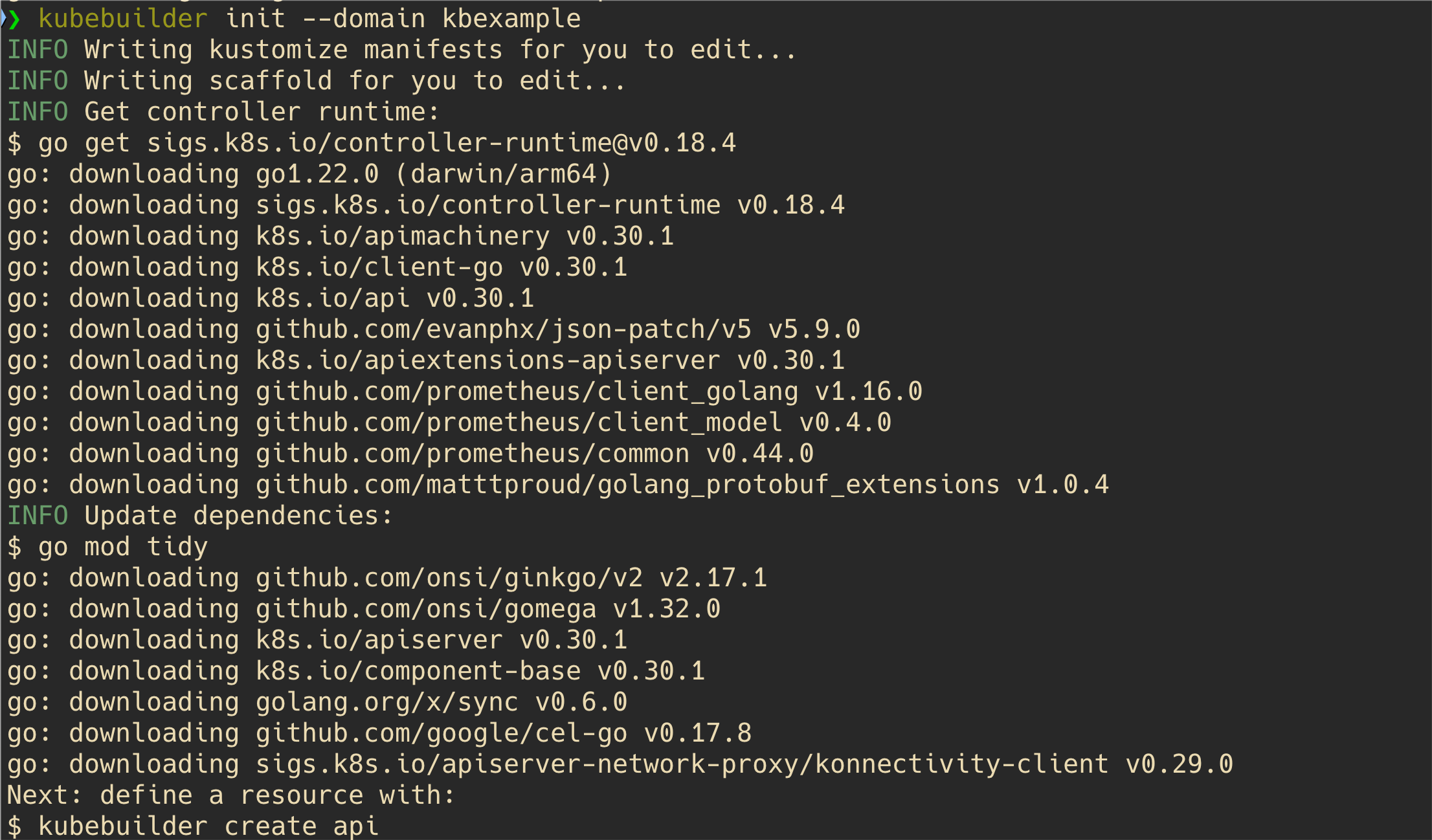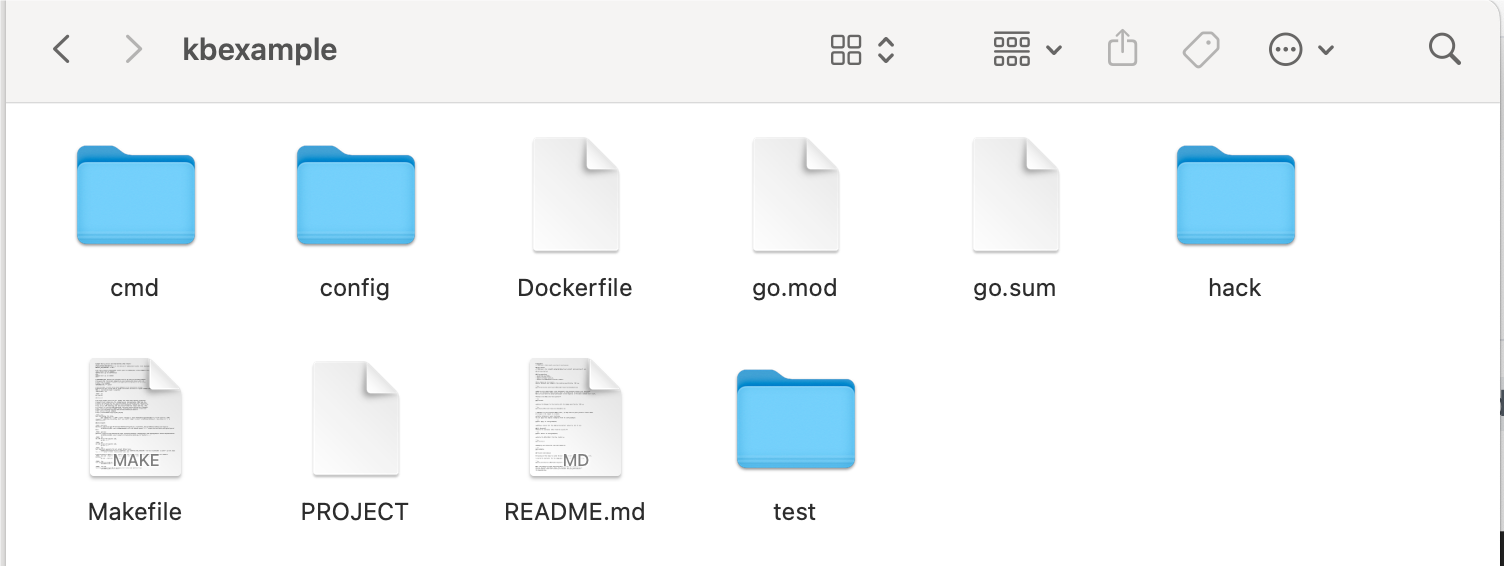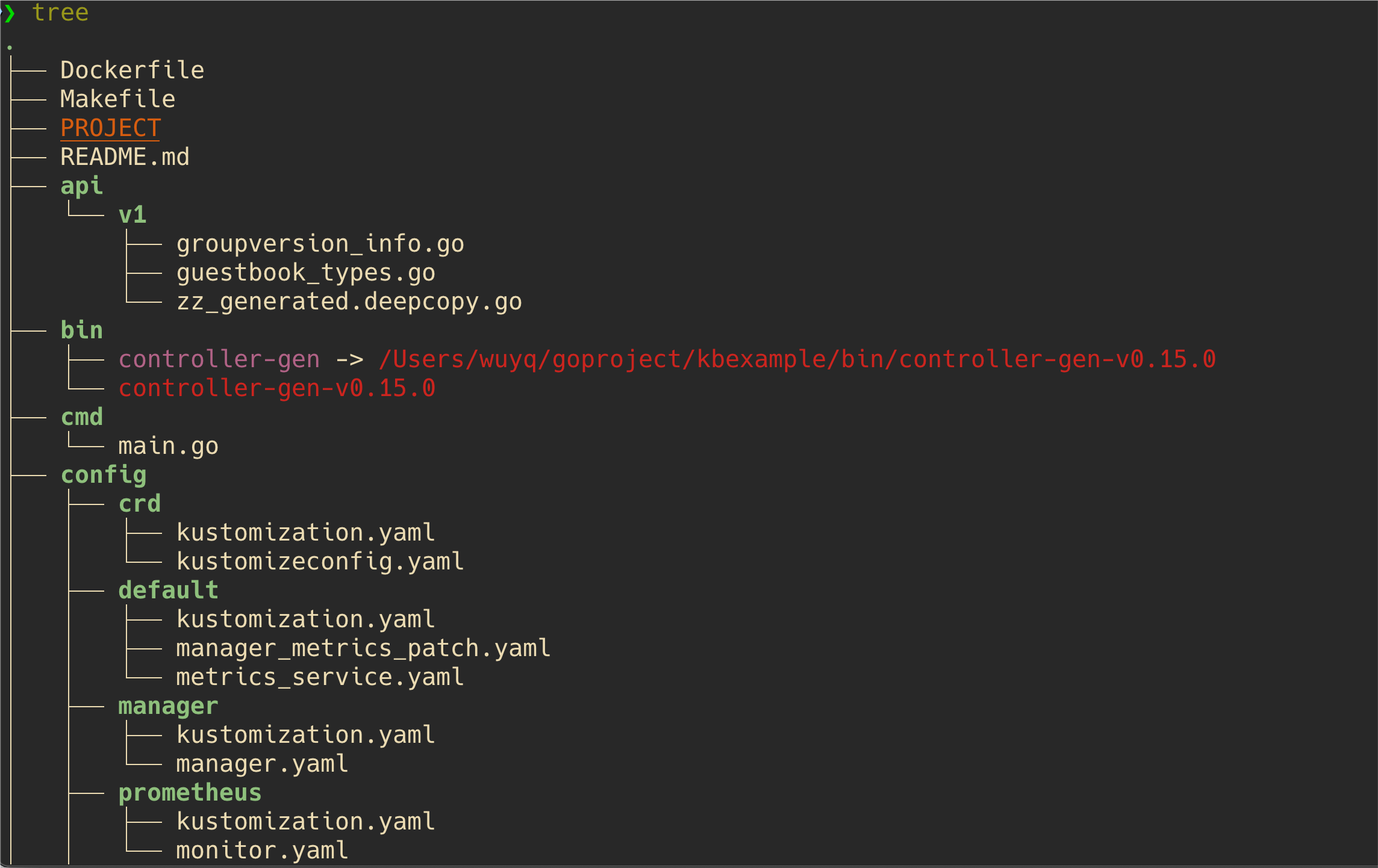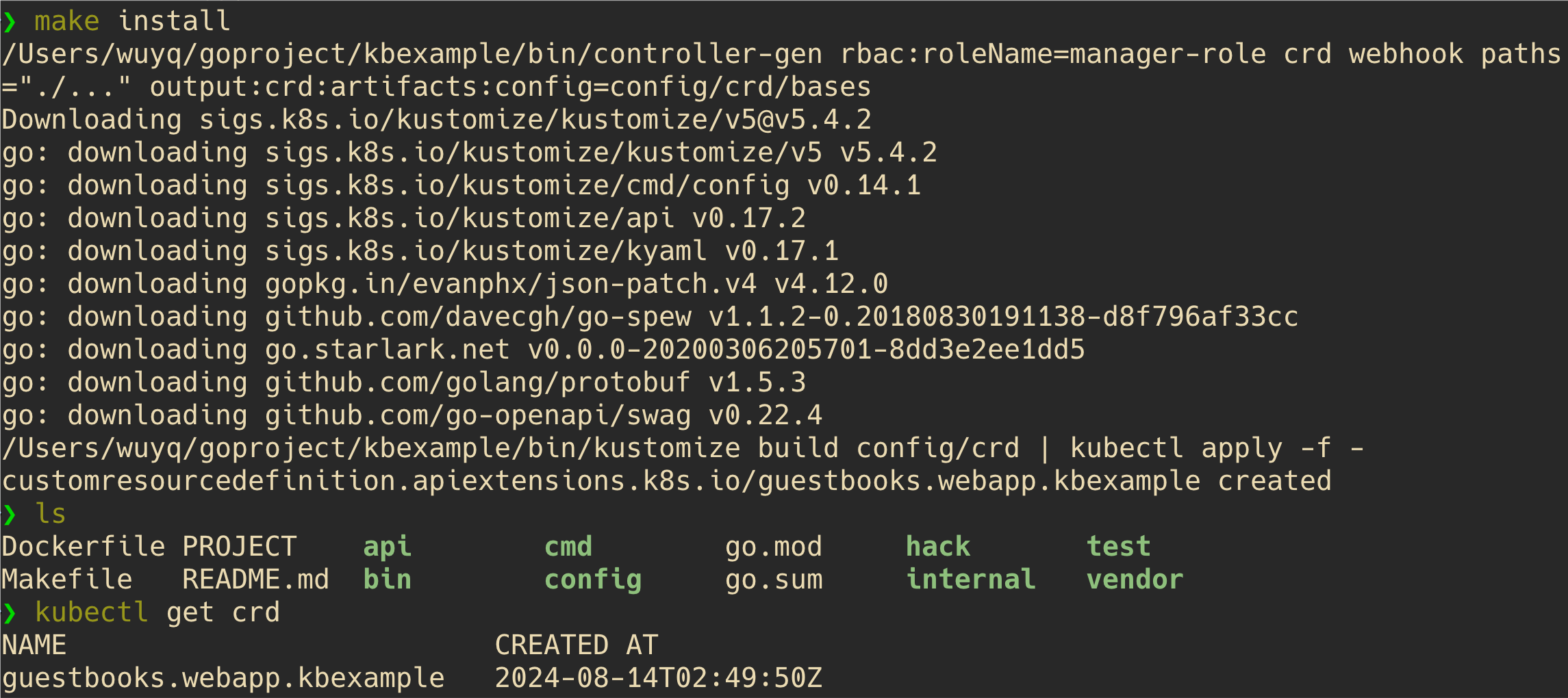.jpeg)
kubebuilder
我们在之前的章节中,看到了用 client-go 和 controller-runtime 实现自定义控制器逻辑,client-go 是最底层的,从 informer 之后所有的东西都需要自己实现,包括请求入队出队操作,controller-runtime 在 client-go 的基础上进行封装,提出了两个抽象:manager、controller,并且通过 controller builder 可以更快地完成控制器编写。但是还是有很多地方需要我们自己重复实现,为此,kubebuilder、operatorSDK 这样的脚手架就有了作用,它可以自动生成 CRD 和控制器框架,我们在这个框架上只需要更改很少的部分。这两个脚手架也是基于 controller-runtime 实现的。
Kubebuilder - SDK for building Kubernetes APIs using CRDs
1、快速入门
这里有一个官方的教程:https://book.kubebuilder.io
1、安装 kubebuilder:
# download kubebuilder and install locally.
curl -L -o kubebuilder "https://go.kubebuilder.io/dl/latest/$(go env GOOS)/$(go env GOARCH)"
chmod +x kubebuilder && sudo mv kubebuilder /usr/local/bin/2、创建一个项目:
mkdir ~/goproject/kbexample
cd ~/goproject/kbexample
kubebuilder init --domain kbexample如果 kubebuilder 安装目录不在
$GOPATH中,你需要运行go mod init <modulename>来告诉 kubebuilder 和 Go module 的基本导入路径。


这样就生成了一系列目录,包括了 makefile 还有 dockerfile,用于打包控制器。
3、创建一个 API:
kubebuilder create api --group webapp --version v1 --kind Guestbook创建了一个新的 API(组/版本)为 “webapp/v1”,并在上面创建新的 Kind(CRD) “Guestbook”。
如果你在 Create Resource [y/n] 和 Create Controller [y/n] 中按
y,那么这将创建文件api/v1/guestbook_types.go,该文件中定义相关 API ,而针对于这一类型 (CRD) 的调谐逻辑生成在controller/guestbook_controller.go文件中。


可以看到生成了很多的文件,有类似于 client-go 方法实现时的一些文件。在 api/v1 下的 types 文件就是 CRD 的定义文件了。
4、测试:
我是在 mac 上用 kind 安装了 k8s 集群:
将 CRD 安装到集群中
make install
运行控制器(这将在前台运行,如果你想让它一直运行,请切换到新的终端)
make run卸载 CRD:
make uninstall卸载控制器:
make undeploy2、实现CronJob
2.1、基本框架
1、初始化项目:
kubebuilder init --domain tutorial.kubebuilder.io2、创建 API:
kubebuilder create api --group batch --version v1 --kind CronJob3、修改 API,把 types 文件改成这样:
/*
Copyright 2024 The Kubernetes authors.
Licensed under the Apache License, Version 2.0 (the "License");
you may not use this file except in compliance with the License.
You may obtain a copy of the License at
http://www.apache.org/licenses/LICENSE-2.0
Unless required by applicable law or agreed to in writing, software
distributed under the License is distributed on an "AS IS" BASIS,
WITHOUT WARRANTIES OR CONDITIONS OF ANY KIND, either express or implied.
See the License for the specific language governing permissions and
limitations under the License.
*/
// +kubebuilder:docs-gen:collapse=Apache License
/*
*/
package v1
/*
*/
import (
batchv1 "k8s.io/api/batch/v1"
corev1 "k8s.io/api/core/v1"
metav1 "k8s.io/apimachinery/pkg/apis/meta/v1"
)
// EDIT THIS FILE! THIS IS SCAFFOLDING FOR YOU TO OWN!
// NOTE: json tags are required. Any new fields you add must have json tags for the fields to be serialized.
// +kubebuilder:docs-gen:collapse=Imports
/*
First, let's take a look at our spec. As we discussed before, spec holds
*desired state*, so any "inputs" to our controller go here.
Fundamentally a CronJob needs the following pieces:
- A schedule (the *cron* in CronJob)
- A template for the Job to run (the
*job* in CronJob)
We'll also want a few extras, which will make our users' lives easier:
- A deadline for starting jobs (if we miss this deadline, we'll just wait till
the next scheduled time)
- What to do if multiple jobs would run at once (do we wait? stop the old one? run both?)
- A way to pause the running of a CronJob, in case something's wrong with it
- Limits on old job history
Remember, since we never read our own status, we need to have some other way to
keep track of whether a job has run. We can use at least one old job to do
this.
We'll use several markers (`// +comment`) to specify additional metadata. These
will be used by [controller-tools](https://github.com/kubernetes-sigs/controller-tools) when generating our CRD manifest.
As we'll see in a bit, controller-tools will also use GoDoc to form descriptions for
the fields.
*/
// CronJobSpec defines the desired state of CronJob
type CronJobSpec struct {
// +kubebuilder:validation:MinLength=0
// The schedule in Cron format, see https://en.wikipedia.org/wiki/Cron.
Schedule string `json:"schedule"`
// +kubebuilder:validation:Minimum=0
// Optional deadline in seconds for starting the job if it misses scheduled
// time for any reason. Missed jobs executions will be counted as failed ones.
// +optional
StartingDeadlineSeconds *int64 `json:"startingDeadlineSeconds,omitempty"`
// Specifies how to treat concurrent executions of a Job.
// Valid values are:
// - "Allow" (default): allows CronJobs to run concurrently;
// - "Forbid": forbids concurrent runs, skipping next run if previous run hasn't finished yet;
// - "Replace": cancels currently running job and replaces it with a new one
// +optional
ConcurrencyPolicy ConcurrencyPolicy `json:"concurrencyPolicy,omitempty"`
// This flag tells the controller to suspend subsequent executions, it does
// not apply to already started executions. Defaults to false.
// +optional
Suspend *bool `json:"suspend,omitempty"`
// Specifies the job that will be created when executing a CronJob.
JobTemplate batchv1.JobTemplateSpec `json:"jobTemplate"`
// +kubebuilder:validation:Minimum=0
// The number of successful finished jobs to retain.
// This is a pointer to distinguish between explicit zero and not specified.
// +optional
SuccessfulJobsHistoryLimit *int32 `json:"successfulJobsHistoryLimit,omitempty"`
// +kubebuilder:validation:Minimum=0
// The number of failed finished jobs to retain.
// This is a pointer to distinguish between explicit zero and not specified.
// +optional
FailedJobsHistoryLimit *int32 `json:"failedJobsHistoryLimit,omitempty"`
}
/*
We define a custom type to hold our concurrency policy. It's actually
just a string under the hood, but the type gives extra documentation,
and allows us to attach validation on the type instead of the field,
making the validation more easily reusable.
*/
// ConcurrencyPolicy describes how the job will be handled.
// Only one of the following concurrent policies may be specified.
// If none of the following policies is specified, the default one
// is AllowConcurrent.
// +kubebuilder:validation:Enum=Allow;Forbid;Replace
type ConcurrencyPolicy string
const (
// AllowConcurrent allows CronJobs to run concurrently.
AllowConcurrent ConcurrencyPolicy = "Allow"
// ForbidConcurrent forbids concurrent runs, skipping next run if previous
// hasn't finished yet.
ForbidConcurrent ConcurrencyPolicy = "Forbid"
// ReplaceConcurrent cancels currently running job and replaces it with a new one.
ReplaceConcurrent ConcurrencyPolicy = "Replace"
)
/*
Next, let's design our status, which holds observed state. It contains any information
we want users or other controllers to be able to easily obtain.
We'll keep a list of actively running jobs, as well as the last time that we successfully
ran our job. Notice that we use `metav1.Time` instead of `time.Time` to get the stable
serialization, as mentioned above.
*/
// CronJobStatus defines the observed state of CronJob
type CronJobStatus struct {
// INSERT ADDITIONAL STATUS FIELD - define observed state of cluster
// Important: Run "make" to regenerate code after modifying this file
// A list of pointers to currently running jobs.
// +optional
Active []corev1.ObjectReference `json:"active,omitempty"`
// Information when was the last time the job was successfully scheduled.
// +optional
LastScheduleTime *metav1.Time `json:"lastScheduleTime,omitempty"`
}
/*
Finally, we have the rest of the boilerplate that we've already discussed.
As previously noted, we don't need to change this, except to mark that
we want a status subresource, so that we behave like built-in kubernetes types.
*/
// +kubebuilder:object:root=true
// +kubebuilder:subresource:status
// CronJob is the Schema for the cronjobs API
type CronJob struct {
/*
*/
metav1.TypeMeta `json:",inline"`
metav1.ObjectMeta `json:"metadata,omitempty"`
Spec CronJobSpec `json:"spec,omitempty"`
Status CronJobStatus `json:"status,omitempty"`
}
// +kubebuilder:object:root=true
// CronJobList contains a list of CronJob
type CronJobList struct {
metav1.TypeMeta `json:",inline"`
metav1.ListMeta `json:"metadata,omitempty"`
Items []CronJob `json:"items"`
}
func init() {
SchemeBuilder.Register(&CronJob{}, &CronJobList{})
}
// +kubebuilder:docs-gen:collapse=Root Object Definitions4、控制器:
控制器是 Kubernetes 的核心,也是任何 operator 的核心。
控制器的工作是确保对于任何给定的对象,世界的实际状态(包括集群状态,以及潜在的外部状态,如 Kubelet 的运行容器或云提供商的负载均衡器)与对象中的期望状态相匹配。每个控制器专注于一个根 Kind,但可能会与其他 Kind 交互。
我们把这个过程称为 reconciling。
在 controller-runtime 中,为特定种类实现 reconciling 的逻辑被称为 Reconciler。 Reconciler 接受一个对象的名称,并返回我们是否需要再次尝试(例如在错误或周期性控制器的情况下,如 HorizontalPodAutoscaler)。
kubebuilder 为我们搭建了一个基本的协调器结构。几乎每个协调器都需要记录,并且需要能够获取对象,因此这些对象是开箱即用的。
// CronJobReconciler reconciles a CronJob object
type CronJobReconciler struct {
client.Client
Scheme *runtime.Scheme
}日志记录句柄让我们可以进行记录。controller-runtime 通过名为 logr 的库使用结构化日志记录。正如我们稍后将看到的,日志记录的工作原理是将键值对附加到静态消息。我们可以在协调方法的顶部预先分配一些对,以便将这些对附加到此协调器中的所有对数行。
func (r *CronJobReconciler) Reconcile(ctx context.Context, req ctrl.Request) (ctrl.Result, error) {
_ = log.FromContext(ctx)
// your logic here
return ctrl.Result{}, nil
}最后,我们将此协调器添加到管理器中,以便在启动管理器时启动它。
func (r *CronJobReconciler) SetupWithManager(mgr ctrl.Manager) error {
return ctrl.NewControllerManagedBy(mgr).
For(&batchv1.CronJob{}).
Complete(r)
}现在我们已经了解了协调器的基本结构,让我们填写 CronJob的逻辑。
2.2、控制器逻辑
我们的 CronJob 控制器的基本逻辑是这样的:
加载命名的 CronJob
列出所有活动 Job,并更新状态
根据历史记录限制清理旧 Job
检查我们是否被暂停(如果我们被暂停,请不要做任何其他事情)
获取下一次计划运行
如果新 Job 按计划进行,未超过截止时间,并且未被我们的并发策略阻止,则运行该 Job
当我们看到正在运行的 Job(自动完成)或需要进行下一次计划运行时,请重新排队。
package controller
import (
"context"
"fmt"
"sort"
"time"
"github.com/robfig/cron"
kbatch "k8s.io/api/batch/v1"
corev1 "k8s.io/api/core/v1"
metav1 "k8s.io/apimachinery/pkg/apis/meta/v1"
"k8s.io/apimachinery/pkg/runtime"
ref "k8s.io/client-go/tools/reference"
ctrl "sigs.k8s.io/controller-runtime"
"sigs.k8s.io/controller-runtime/pkg/client"
"sigs.k8s.io/controller-runtime/pkg/log"
batchv1 "tutorial.kubebuilder.io/project/api/v1"
)接下来,我们需要一个时钟,这将使我们能够在测试中伪造计时。
// CronJobReconciler reconciles a CronJob object
type CronJobReconciler struct {
client.Client
Scheme *runtime.Scheme
Clock
}
type realClock struct{}
func (_ realClock) Now() time.Time { return time.Now() }
// Clock knows how to get the current time.
// It can be used to fake out timing for testing.
type Clock interface {
Now() time.Time
}请注意,我们需要更多的 RBAC 权限 - 由于我们现在正在创建和管理作业,因此我们需要这些权限。
// +kubebuilder:rbac:groups=batch.tutorial.kubebuilder.io,resources=cronjobs,verbs=get;list;watch;create;update;patch;delete
// +kubebuilder:rbac:groups=batch.tutorial.kubebuilder.io,resources=cronjobs/status,verbs=get;update;patch
// +kubebuilder:rbac:groups=batch.tutorial.kubebuilder.io,resources=cronjobs/finalizers,verbs=update
// +kubebuilder:rbac:groups=batch,resources=jobs,verbs=get;list;watch;create;update;patch;delete
// +kubebuilder:rbac:groups=batch,resources=jobs/status,verbs=get现在,我们进入了控制器的核心——协调器逻辑。
var (
scheduledTimeAnnotation = "batch.tutorial.kubebuilder.io/scheduled-at"
)
// Reconcile is part of the main kubernetes reconciliation loop which aims to
// move the current state of the cluster closer to the desired state.
// TODO(user): Modify the Reconcile function to compare the state specified by
// the CronJob object against the actual cluster state, and then
// perform operations to make the cluster state reflect the state specified by
// the user.
//
// For more details, check Reconcile and its Result here:
// - https://pkg.go.dev/sigs.k8s.io/controller-runtime@v0.18.4/pkg/reconcile
func (r *CronJobReconciler) Reconcile(ctx context.Context, req ctrl.Request) (ctrl.Result, error) {
log := log.FromContext(ctx)2.2.1、按名称加载 CronJob
我们将使用客户端获取 CronJob。所有客户端方法都采用上下文作为其第一个参数,并将相关对象作为其最后一个参数。Get 有点特别,因为它将 NamespacedName 作为中间参数(大多数没有中间参数,我们将在下面看到)。
var cronJob batchv1.CronJob
if err := r.Get(ctx, req.NamespacedName, &cronJob); err != nil {
log.Error(err, "unable to fetch CronJob")
// we'll ignore not-found errors, since they can't be fixed by an immediate
// requeue (we'll need to wait for a new notification), and we can get them
// on deleted requests.
return ctrl.Result{}, client.IgnoreNotFound(err)
}2.2.2、列出所有活动作业,并更新状态
为了完全更新我们的状态,我们需要列出此命名空间中属于此 CronJob 的所有子 Job。与 Get 类似,我们可以使用 List 方法来列出子 Job。请注意,我们使用可变参数选项来设置命名空间和字段匹配(这实际上是我们在下面设置的索引查找)。
var childJobs kbatch.JobList
if err := r.List(ctx, &childJobs, client.InNamespace(req.Namespace), client.MatchingFields{jobOwnerKey: req.Name}); err != nil {
log.Error(err, "unable to list child Jobs")
return ctrl.Result{}, err
}指数是什么:协调器获取 cronjob 所拥有的所有 Job 的状态。随着我们的 cronjobs 数量的增加,查找这些 Jobs 可能会变得非常缓慢,因为我们必须过滤掉所有 cronjobs。为了更高效地查找,这些 Job 将根据控制器的名称在本地编制索引。jobOwnerKey 字段将添加到缓存的作业对象中。此键引用所属控制器并用作索引。在本文档的后面部分,我们将配置管理器以实际索引此字段。
一旦我们拥有了我们拥有的所有 Job,我们就会将它们分为活动 Job、成功 Job 和失败 Job,并跟踪最近的运行,以便我们可以记录它的状态。
我们可以使用状态条件检查 Job 是否“已完成”以及它是成功还是失败。我们将把这个逻辑放在一个帮助程序中,以使我们的代码更清晰。
// find the active list of jobs
var activeJobs []*kbatch.Job
var successfulJobs []*kbatch.Job
var failedJobs []*kbatch.Job
var mostRecentTime *time.Time // find the last run so we can update the status如果作业具有标记为 true 的“完成”或“失败”条件,则该作业为“已完成”。状态条件允许我们向对象添加可扩展的状态信息,其他人和控制器可以检查这些信息,以检查完成和运行状况等内容。
isJobFinished := func(job *kbatch.Job) (bool, kbatch.JobConditionType) {
for _, c := range job.Status.Conditions {
if (c.Type == kbatch.JobComplete || c.Type == kbatch.JobFailed) && c.Status == corev1.ConditionTrue {
return true, c.Type
}
}
return false, ""
}我们将使用帮助程序从我们在作业创建期间添加的注释中提取计划时间。
getScheduledTimeForJob := func(job *kbatch.Job) (*time.Time, error) {
timeRaw := job.Annotations[scheduledTimeAnnotation]
if len(timeRaw) == 0 {
return nil, nil
}
timeParsed, err := time.Parse(time.RFC3339, timeRaw)
if err != nil {
return nil, err
}
return &timeParsed, nil
}
for i, job := range childJobs.Items {
_, finishedType := isJobFinished(&job)
switch finishedType {
case "": // ongoing
activeJobs = append(activeJobs, &childJobs.Items[i])
case kbatch.JobFailed:
failedJobs = append(failedJobs, &childJobs.Items[i])
case kbatch.JobComplete:
successfulJobs = append(successfulJobs, &childJobs.Items[i])
}
// We'll store the launch time in an annotation, so we'll reconstitute that from
// the active jobs themselves.
scheduledTimeForJob, err := getScheduledTimeForJob(&job)
if err != nil {
log.Error(err, "unable to parse schedule time for child job", "job", &job)
continue
}
if scheduledTimeForJob != nil {
if mostRecentTime == nil || mostRecentTime.Before(*scheduledTimeForJob) {
mostRecentTime = scheduledTimeForJob
}
}
}
if mostRecentTime != nil {
cronJob.Status.LastScheduleTime = &metav1.Time{Time: *mostRecentTime}
} else {
cronJob.Status.LastScheduleTime = nil
}
cronJob.Status.Active = nil
for _, activeJob := range activeJobs {
jobRef, err := ref.GetReference(r.Scheme, activeJob)
if err != nil {
log.Error(err, "unable to make reference to active job", "job", activeJob)
continue
}
cronJob.Status.Active = append(cronJob.Status.Active, *jobRef)
}在这里,我们将记录在稍高的日志记录级别观察到的作业数量,以便进行调试。请注意,我们如何使用固定消息而不是使用格式字符串,并使用额外信息附加键值对。这样可以更轻松地筛选和查询日志行。
log.V(1).Info("job count", "active jobs", len(activeJobs), "successful jobs", len(successfulJobs), "failed jobs", len(failedJobs))使用我们收集的数据,我们将更新 CRD 的状态。就像以前一样,我们使用我们的客户。为了专门更新 status 子资源,我们将使用客户端的 Status 部分和 Update 方法。status 子资源会忽略对规范的更改,因此它不太可能与任何其他更新发生冲突,并且可以具有单独的权限。
if err := r.Status().Update(ctx, &cronJob); err != nil {
log.Error(err, "unable to update CronJob status")
return ctrl.Result{}, err
}一旦我们更新了我们的状态,我们就可以继续确保状态与我们在规范中想要的相匹配。
2.2.3、根据历史记录限制清理旧 Job
// NB: deleting these are "best effort" -- if we fail on a particular one,
// we won't requeue just to finish the deleting.
if cronJob.Spec.FailedJobsHistoryLimit != nil {
sort.Slice(failedJobs, func(i, j int) bool {
if failedJobs[i].Status.StartTime == nil {
return failedJobs[j].Status.StartTime != nil
}
return failedJobs[i].Status.StartTime.Before(failedJobs[j].Status.StartTime)
})
for i, job := range failedJobs {
if int32(i) >= int32(len(failedJobs))-*cronJob.Spec.FailedJobsHistoryLimit {
break
}
if err := r.Delete(ctx, job, client.PropagationPolicy(metav1.DeletePropagationBackground)); client.IgnoreNotFound(err) != nil {
log.Error(err, "unable to delete old failed job", "job", job)
} else {
log.V(0).Info("deleted old failed job", "job", job)
}
}
}
if cronJob.Spec.SuccessfulJobsHistoryLimit != nil {
sort.Slice(successfulJobs, func(i, j int) bool {
if successfulJobs[i].Status.StartTime == nil {
return successfulJobs[j].Status.StartTime != nil
}
return successfulJobs[i].Status.StartTime.Before(successfulJobs[j].Status.StartTime)
})
for i, job := range successfulJobs {
if int32(i) >= int32(len(successfulJobs))-*cronJob.Spec.SuccessfulJobsHistoryLimit {
break
}
if err := r.Delete(ctx, job, client.PropagationPolicy(metav1.DeletePropagationBackground)); err != nil {
log.Error(err, "unable to delete old successful job", "job", job)
} else {
log.V(0).Info("deleted old successful job", "job", job)
}
}
}2.2.4、检查是否被暂停
如果此对象被挂起,我们不想运行任何作业,因此我们现在将停止。如果我们正在运行的作业出现问题,并且我们希望暂停运行以调查或放置集群,而不删除对象,这将非常有用。
if cronJob.Spec.Suspend != nil && *cronJob.Spec.Suspend {
log.V(1).Info("cronjob suspended, skipping")
return ctrl.Result{}, nil
}2.2.5、获取下一次计划
如果我们没有暂停,我们将需要计算下一个计划的运行,以及我们是否有尚未处理的运行。
我们将使用我们有用的 cron 库来计算下一个计划时间。我们将开始计算上次运行的适当时间,或者如果找不到最后一次运行,则开始计算创建 CronJob 的适当时间。
如果错过的运行次数太多,并且我们没有设置任何截止日期,我们将保释,以免在控制器重启或楔子上引起问题。
否则,我们将只返回错过的运行(我们只使用最新的)和下一次运行,以便我们知道何时该再次协调。
getNextSchedule := func(cronJob *batchv1.CronJob, now time.Time) (lastMissed time.Time, next time.Time, err error) {
sched, err := cron.ParseStandard(cronJob.Spec.Schedule)
if err != nil {
return time.Time{}, time.Time{}, fmt.Errorf("Unparseable schedule %q: %v", cronJob.Spec.Schedule, err)
}
// for optimization purposes, cheat a bit and start from our last observed run time
// we could reconstitute this here, but there's not much point, since we've
// just updated it.
var earliestTime time.Time
if cronJob.Status.LastScheduleTime != nil {
earliestTime = cronJob.Status.LastScheduleTime.Time
} else {
earliestTime = cronJob.ObjectMeta.CreationTimestamp.Time
}
if cronJob.Spec.StartingDeadlineSeconds != nil {
// controller is not going to schedule anything below this point
schedulingDeadline := now.Add(-time.Second * time.Duration(*cronJob.Spec.StartingDeadlineSeconds))
if schedulingDeadline.After(earliestTime) {
earliestTime = schedulingDeadline
}
}
if earliestTime.After(now) {
return time.Time{}, sched.Next(now), nil
}
starts := 0
for t := sched.Next(earliestTime); !t.After(now); t = sched.Next(t) {
lastMissed = t
// An object might miss several starts. For example, if
// controller gets wedged on Friday at 5:01pm when everyone has
// gone home, and someone comes in on Tuesday AM and discovers
// the problem and restarts the controller, then all the hourly
// jobs, more than 80 of them for one hourly scheduledJob, should
// all start running with no further intervention (if the scheduledJob
// allows concurrency and late starts).
//
// However, if there is a bug somewhere, or incorrect clock
// on controller's server or apiservers (for setting creationTimestamp)
// then there could be so many missed start times (it could be off
// by decades or more), that it would eat up all the CPU and memory
// of this controller. In that case, we want to not try to list
// all the missed start times.
starts++
if starts > 100 {
// We can't get the most recent times so just return an empty slice
return time.Time{}, time.Time{}, fmt.Errorf("Too many missed start times (> 100). Set or decrease .spec.startingDeadlineSeconds or check clock skew.")
}
}
return lastMissed, sched.Next(now), nil
} // figure out the next times that we need to create
// jobs at (or anything we missed).
missedRun, nextRun, err := getNextSchedule(&cronJob, r.Now())
if err != nil {
log.Error(err, "unable to figure out CronJob schedule")
// we don't really care about requeuing until we get an update that
// fixes the schedule, so don't return an error
return ctrl.Result{}, nil
}我们将准备最终的请求,以重新排队直到下一个作业,然后弄清楚我们是否真的需要运行。
scheduledResult := ctrl.Result{RequeueAfter: nextRun.Sub(r.Now())} // save this so we can re-use it elsewhere
log = log.WithValues("now", r.Now(), "next run", nextRun)2.2.6、如果新 Job 按计划进行,未超过截止时间,并且未被我们的并发策略阻止,则运行新 Job
如果我们错过了一次运行,并且我们仍然在启动它的最后期限内,我们将需要运行一个作业。
if missedRun.IsZero() {
log.V(1).Info("no upcoming scheduled times, sleeping until next")
return scheduledResult, nil
}
// make sure we're not too late to start the run
log = log.WithValues("current run", missedRun)
tooLate := false
if cronJob.Spec.StartingDeadlineSeconds != nil {
tooLate = missedRun.Add(time.Duration(*cronJob.Spec.StartingDeadlineSeconds) * time.Second).Before(r.Now())
}
if tooLate {
log.V(1).Info("missed starting deadline for last run, sleeping till next")
// TODO(directxman12): events
return scheduledResult, nil
}如果我们真的必须运行一个 Job,我们需要等到现有 Job完成,替换现有的 Job,或者只是添加新的 Job。如果由于缓存延迟而导致信息过期,我们将在获取最新信息时重新排队。
// figure out how to run this job -- concurrency policy might forbid us from running
// multiple at the same time...
if cronJob.Spec.ConcurrencyPolicy == batchv1.ForbidConcurrent && len(activeJobs) > 0 {
log.V(1).Info("concurrency policy blocks concurrent runs, skipping", "num active", len(activeJobs))
return scheduledResult, nil
}
// ...or instruct us to replace existing ones...
if cronJob.Spec.ConcurrencyPolicy == batchv1.ReplaceConcurrent {
for _, activeJob := range activeJobs {
// we don't care if the job was already deleted
if err := r.Delete(ctx, activeJob, client.PropagationPolicy(metav1.DeletePropagationBackground)); client.IgnoreNotFound(err) != nil {
log.Error(err, "unable to delete active job", "job", activeJob)
return ctrl.Result{}, err
}
}
}constructJobForCronJob := func(cronJob *batchv1.CronJob, scheduledTime time.Time) (*kbatch.Job, error) {
// We want job names for a given nominal start time to have a deterministic name to avoid the same job being created twice
name := fmt.Sprintf("%s-%d", cronJob.Name, scheduledTime.Unix())
job := &kbatch.Job{
ObjectMeta: metav1.ObjectMeta{
Labels: make(map[string]string),
Annotations: make(map[string]string),
Name: name,
Namespace: cronJob.Namespace,
},
Spec: *cronJob.Spec.JobTemplate.Spec.DeepCopy(),
}
for k, v := range cronJob.Spec.JobTemplate.Annotations {
job.Annotations[k] = v
}
job.Annotations[scheduledTimeAnnotation] = scheduledTime.Format(time.RFC3339)
for k, v := range cronJob.Spec.JobTemplate.Labels {
job.Labels[k] = v
}
if err := ctrl.SetControllerReference(cronJob, job, r.Scheme); err != nil {
return nil, err
}
return job, nil
}一旦我们弄清楚如何处理现有的 Job,我们就会真正创造出我们想要的 Job:
// actually make the job...
job, err := constructJobForCronJob(&cronJob, missedRun)
if err != nil {
log.Error(err, "unable to construct job from template")
// don't bother requeuing until we get a change to the spec
return scheduledResult, nil
}
// ...and create it on the cluster
if err := r.Create(ctx, job); err != nil {
log.Error(err, "unable to create Job for CronJob", "job", job)
return ctrl.Result{}, err
}
log.V(1).Info("created Job for CronJob run", "job", job)2.2.7、当我们看到正在运行的作业或需要进行下一次计划运行时,请重新排队
最后,我们将返回我们上面准备的结果,即我们希望在需要进行下一次运行时重新排队。这被视为最长期限——如果在此期间有其他变化,例如我们的工作开始或结束,我们被修改等,我们可能会更快地再次和解。
// we'll requeue once we see the running job, and update our status
return scheduledResult, nil
}2.2.8、setup设置
最后,我们将更新我们的设置。为了让我们的协调器能够快速查找其所有者的 Jobs,我们需要一个索引。我们声明一个索引键,稍后可以作为伪字段名称与客户端一起使用,然后描述如何从 Job 对象中提取索引值。索引器将自动为我们处理命名空间,因此,如果作业具有 CronJob 所有者,我们只需提取所有者名称。
此外,我们将通知经理此控制器拥有一些作业,以便在作业更改、删除等时,它将自动在底层 CronJob 上调用 Reconcile。
var (
jobOwnerKey = ".metadata.controller"
apiGVStr = batchv1.GroupVersion.String()
)
// SetupWithManager sets up the controller with the Manager.
func (r *CronJobReconciler) SetupWithManager(mgr ctrl.Manager) error {
// set up a real clock, since we're not in a test
if r.Clock == nil {
r.Clock = realClock{}
}
if err := mgr.GetFieldIndexer().IndexField(context.Background(), &kbatch.Job{}, jobOwnerKey, func(rawObj client.Object) []string {
// grab the job object, extract the owner...
job := rawObj.(*kbatch.Job)
owner := metav1.GetControllerOf(job)
if owner == nil {
return nil
}
// ...make sure it's a CronJob...
if owner.APIVersion != apiGVStr || owner.Kind != "CronJob" {
return nil
}
// ...and if so, return it
return []string{owner.Name}
}); err != nil {
return err
}
return ctrl.NewControllerManagedBy(mgr).
For(&batchv1.CronJob{}).
Owns(&kbatch.Job{}).
Complete(r)
}2.2.9、总体文件
/*
Copyright 2024 The Kubernetes authors.
Licensed under the Apache License, Version 2.0 (the "License");
you may not use this file except in compliance with the License.
You may obtain a copy of the License at
http://www.apache.org/licenses/LICENSE-2.0
Unless required by applicable law or agreed to in writing, software
distributed under the License is distributed on an "AS IS" BASIS,
WITHOUT WARRANTIES OR CONDITIONS OF ANY KIND, either express or implied.
See the License for the specific language governing permissions and
limitations under the License.
*/
// +kubebuilder:docs-gen:collapse=Apache License
/*
We'll start out with some imports. You'll see below that we'll need a few more imports
than those scaffolded for us. We'll talk about each one when we use it.
*/
package controller
import (
"context"
"fmt"
"sort"
"time"
"github.com/robfig/cron"
kbatch "k8s.io/api/batch/v1"
corev1 "k8s.io/api/core/v1"
metav1 "k8s.io/apimachinery/pkg/apis/meta/v1"
"k8s.io/apimachinery/pkg/runtime"
ref "k8s.io/client-go/tools/reference"
ctrl "sigs.k8s.io/controller-runtime"
"sigs.k8s.io/controller-runtime/pkg/client"
"sigs.k8s.io/controller-runtime/pkg/log"
batchv1 "tutorial.kubebuilder.io/project/api/v1"
)
/*
Next, we'll need a Clock, which will allow us to fake timing in our tests.
*/
// CronJobReconciler reconciles a CronJob object
type CronJobReconciler struct {
client.Client
Scheme *runtime.Scheme
Clock
}
/*
We'll mock out the clock to make it easier to jump around in time while testing,
the "real" clock just calls `time.Now`.
*/
type realClock struct{}
func (_ realClock) Now() time.Time { return time.Now() }
// Clock knows how to get the current time.
// It can be used to fake out timing for testing.
type Clock interface {
Now() time.Time
}
// +kubebuilder:docs-gen:collapse=Clock
/*
Notice that we need a few more RBAC permissions -- since we're creating and
managing jobs now, we'll need permissions for those, which means adding
a couple more [markers](/reference/markers/rbac.md).
*/
// +kubebuilder:rbac:groups=batch.tutorial.kubebuilder.io,resources=cronjobs,verbs=get;list;watch;create;update;patch;delete
// +kubebuilder:rbac:groups=batch.tutorial.kubebuilder.io,resources=cronjobs/status,verbs=get;update;patch
// +kubebuilder:rbac:groups=batch.tutorial.kubebuilder.io,resources=cronjobs/finalizers,verbs=update
// +kubebuilder:rbac:groups=batch,resources=jobs,verbs=get;list;watch;create;update;patch;delete
// +kubebuilder:rbac:groups=batch,resources=jobs/status,verbs=get
/*
Now, we get to the heart of the controller -- the reconciler logic.
*/
var (
scheduledTimeAnnotation = "batch.tutorial.kubebuilder.io/scheduled-at"
)
// Reconcile is part of the main kubernetes reconciliation loop which aims to
// move the current state of the cluster closer to the desired state.
// TODO(user): Modify the Reconcile function to compare the state specified by
// the CronJob object against the actual cluster state, and then
// perform operations to make the cluster state reflect the state specified by
// the user.
//
// For more details, check Reconcile and its Result here:
// - https://pkg.go.dev/sigs.k8s.io/controller-runtime@v0.18.4/pkg/reconcile
func (r *CronJobReconciler) Reconcile(ctx context.Context, req ctrl.Request) (ctrl.Result, error) {
log := log.FromContext(ctx)
/*
### 1: Load the CronJob by name
We'll fetch the CronJob using our client. All client methods take a
context (to allow for cancellation) as their first argument, and the object
in question as their last. Get is a bit special, in that it takes a
[`NamespacedName`](https://pkg.go.dev/sigs.k8s.io/controller-runtime/pkg/client?tab=doc#ObjectKey)
as the middle argument (most don't have a middle argument, as we'll see
below).
Many client methods also take variadic options at the end.
*/
var cronJob batchv1.CronJob
if err := r.Get(ctx, req.NamespacedName, &cronJob); err != nil {
log.Error(err, "unable to fetch CronJob")
// we'll ignore not-found errors, since they can't be fixed by an immediate
// requeue (we'll need to wait for a new notification), and we can get them
// on deleted requests.
return ctrl.Result{}, client.IgnoreNotFound(err)
}
/*
### 2: List all active jobs, and update the status
To fully update our status, we'll need to list all child jobs in this namespace that belong to this CronJob.
Similarly to Get, we can use the List method to list the child jobs. Notice that we use variadic options to
set the namespace and field match (which is actually an index lookup that we set up below).
*/
var childJobs kbatch.JobList
if err := r.List(ctx, &childJobs, client.InNamespace(req.Namespace), client.MatchingFields{jobOwnerKey: req.Name}); err != nil {
log.Error(err, "unable to list child Jobs")
return ctrl.Result{}, err
}
/*
<aside class="note">
<h1>What is this index about?</h1>
<p>The reconciler fetches all jobs owned by the cronjob for the status. As our number of cronjobs increases,
looking these up can become quite slow as we have to filter through all of them. For a more efficient lookup,
these jobs will be indexed locally on the controller's name. A jobOwnerKey field is added to the
cached job objects. This key references the owning controller and functions as the index. Later in this
document we will configure the manager to actually index this field.</p>
</aside>
Once we have all the jobs we own, we'll split them into active, successful,
and failed jobs, keeping track of the most recent run so that we can record it
in status. Remember, status should be able to be reconstituted from the state
of the world, so it's generally not a good idea to read from the status of the
root object. Instead, you should reconstruct it every run. That's what we'll
do here.
We can check if a job is "finished" and whether it succeeded or failed using status
conditions. We'll put that logic in a helper to make our code cleaner.
*/
// find the active list of jobs
var activeJobs []*kbatch.Job
var successfulJobs []*kbatch.Job
var failedJobs []*kbatch.Job
var mostRecentTime *time.Time // find the last run so we can update the status
/*
We consider a job "finished" if it has a "Complete" or "Failed" condition marked as true.
Status conditions allow us to add extensible status information to our objects that other
humans and controllers can examine to check things like completion and health.
*/
isJobFinished := func(job *kbatch.Job) (bool, kbatch.JobConditionType) {
for _, c := range job.Status.Conditions {
if (c.Type == kbatch.JobComplete || c.Type == kbatch.JobFailed) && c.Status == corev1.ConditionTrue {
return true, c.Type
}
}
return false, ""
}
// +kubebuilder:docs-gen:collapse=isJobFinished
/*
We'll use a helper to extract the scheduled time from the annotation that
we added during job creation.
*/
getScheduledTimeForJob := func(job *kbatch.Job) (*time.Time, error) {
timeRaw := job.Annotations[scheduledTimeAnnotation]
if len(timeRaw) == 0 {
return nil, nil
}
timeParsed, err := time.Parse(time.RFC3339, timeRaw)
if err != nil {
return nil, err
}
return &timeParsed, nil
}
// +kubebuilder:docs-gen:collapse=getScheduledTimeForJob
for i, job := range childJobs.Items {
_, finishedType := isJobFinished(&job)
switch finishedType {
case "": // ongoing
activeJobs = append(activeJobs, &childJobs.Items[i])
case kbatch.JobFailed:
failedJobs = append(failedJobs, &childJobs.Items[i])
case kbatch.JobComplete:
successfulJobs = append(successfulJobs, &childJobs.Items[i])
}
// We'll store the launch time in an annotation, so we'll reconstitute that from
// the active jobs themselves.
scheduledTimeForJob, err := getScheduledTimeForJob(&job)
if err != nil {
log.Error(err, "unable to parse schedule time for child job", "job", &job)
continue
}
if scheduledTimeForJob != nil {
if mostRecentTime == nil || mostRecentTime.Before(*scheduledTimeForJob) {
mostRecentTime = scheduledTimeForJob
}
}
}
if mostRecentTime != nil {
cronJob.Status.LastScheduleTime = &metav1.Time{Time: *mostRecentTime}
} else {
cronJob.Status.LastScheduleTime = nil
}
cronJob.Status.Active = nil
for _, activeJob := range activeJobs {
jobRef, err := ref.GetReference(r.Scheme, activeJob)
if err != nil {
log.Error(err, "unable to make reference to active job", "job", activeJob)
continue
}
cronJob.Status.Active = append(cronJob.Status.Active, *jobRef)
}
/*
Here, we'll log how many jobs we observed at a slightly higher logging level,
for debugging. Notice how instead of using a format string, we use a fixed message,
and attach key-value pairs with the extra information. This makes it easier to
filter and query log lines.
*/
log.V(1).Info("job count", "active jobs", len(activeJobs), "successful jobs", len(successfulJobs), "failed jobs", len(failedJobs))
/*
Using the data we've gathered, we'll update the status of our CRD.
Just like before, we use our client. To specifically update the status
subresource, we'll use the `Status` part of the client, with the `Update`
method.
The status subresource ignores changes to spec, so it's less likely to conflict
with any other updates, and can have separate permissions.
*/
if err := r.Status().Update(ctx, &cronJob); err != nil {
log.Error(err, "unable to update CronJob status")
return ctrl.Result{}, err
}
/*
Once we've updated our status, we can move on to ensuring that the status of
the world matches what we want in our spec.
### 3: Clean up old jobs according to the history limit
First, we'll try to clean up old jobs, so that we don't leave too many lying
around.
*/
// NB: deleting these are "best effort" -- if we fail on a particular one,
// we won't requeue just to finish the deleting.
if cronJob.Spec.FailedJobsHistoryLimit != nil {
sort.Slice(failedJobs, func(i, j int) bool {
if failedJobs[i].Status.StartTime == nil {
return failedJobs[j].Status.StartTime != nil
}
return failedJobs[i].Status.StartTime.Before(failedJobs[j].Status.StartTime)
})
for i, job := range failedJobs {
if int32(i) >= int32(len(failedJobs))-*cronJob.Spec.FailedJobsHistoryLimit {
break
}
if err := r.Delete(ctx, job, client.PropagationPolicy(metav1.DeletePropagationBackground)); client.IgnoreNotFound(err) != nil {
log.Error(err, "unable to delete old failed job", "job", job)
} else {
log.V(0).Info("deleted old failed job", "job", job)
}
}
}
if cronJob.Spec.SuccessfulJobsHistoryLimit != nil {
sort.Slice(successfulJobs, func(i, j int) bool {
if successfulJobs[i].Status.StartTime == nil {
return successfulJobs[j].Status.StartTime != nil
}
return successfulJobs[i].Status.StartTime.Before(successfulJobs[j].Status.StartTime)
})
for i, job := range successfulJobs {
if int32(i) >= int32(len(successfulJobs))-*cronJob.Spec.SuccessfulJobsHistoryLimit {
break
}
if err := r.Delete(ctx, job, client.PropagationPolicy(metav1.DeletePropagationBackground)); err != nil {
log.Error(err, "unable to delete old successful job", "job", job)
} else {
log.V(0).Info("deleted old successful job", "job", job)
}
}
}
/* ### 4: Check if we're suspended
If this object is suspended, we don't want to run any jobs, so we'll stop now.
This is useful if something's broken with the job we're running and we want to
pause runs to investigate or putz with the cluster, without deleting the object.
*/
if cronJob.Spec.Suspend != nil && *cronJob.Spec.Suspend {
log.V(1).Info("cronjob suspended, skipping")
return ctrl.Result{}, nil
}
/*
### 5: Get the next scheduled run
If we're not paused, we'll need to calculate the next scheduled run, and whether
or not we've got a run that we haven't processed yet.
*/
/*
We'll calculate the next scheduled time using our helpful cron library.
We'll start calculating appropriate times from our last run, or the creation
of the CronJob if we can't find a last run.
If there are too many missed runs and we don't have any deadlines set, we'll
bail so that we don't cause issues on controller restarts or wedges.
Otherwise, we'll just return the missed runs (of which we'll just use the latest),
and the next run, so that we can know when it's time to reconcile again.
*/
getNextSchedule := func(cronJob *batchv1.CronJob, now time.Time) (lastMissed time.Time, next time.Time, err error) {
sched, err := cron.ParseStandard(cronJob.Spec.Schedule)
if err != nil {
return time.Time{}, time.Time{}, fmt.Errorf("Unparseable schedule %q: %v", cronJob.Spec.Schedule, err)
}
// for optimization purposes, cheat a bit and start from our last observed run time
// we could reconstitute this here, but there's not much point, since we've
// just updated it.
var earliestTime time.Time
if cronJob.Status.LastScheduleTime != nil {
earliestTime = cronJob.Status.LastScheduleTime.Time
} else {
earliestTime = cronJob.ObjectMeta.CreationTimestamp.Time
}
if cronJob.Spec.StartingDeadlineSeconds != nil {
// controller is not going to schedule anything below this point
schedulingDeadline := now.Add(-time.Second * time.Duration(*cronJob.Spec.StartingDeadlineSeconds))
if schedulingDeadline.After(earliestTime) {
earliestTime = schedulingDeadline
}
}
if earliestTime.After(now) {
return time.Time{}, sched.Next(now), nil
}
starts := 0
for t := sched.Next(earliestTime); !t.After(now); t = sched.Next(t) {
lastMissed = t
// An object might miss several starts. For example, if
// controller gets wedged on Friday at 5:01pm when everyone has
// gone home, and someone comes in on Tuesday AM and discovers
// the problem and restarts the controller, then all the hourly
// jobs, more than 80 of them for one hourly scheduledJob, should
// all start running with no further intervention (if the scheduledJob
// allows concurrency and late starts).
//
// However, if there is a bug somewhere, or incorrect clock
// on controller's server or apiservers (for setting creationTimestamp)
// then there could be so many missed start times (it could be off
// by decades or more), that it would eat up all the CPU and memory
// of this controller. In that case, we want to not try to list
// all the missed start times.
starts++
if starts > 100 {
// We can't get the most recent times so just return an empty slice
return time.Time{}, time.Time{}, fmt.Errorf("Too many missed start times (> 100). Set or decrease .spec.startingDeadlineSeconds or check clock skew.")
}
}
return lastMissed, sched.Next(now), nil
}
// +kubebuilder:docs-gen:collapse=getNextSchedule
// figure out the next times that we need to create
// jobs at (or anything we missed).
missedRun, nextRun, err := getNextSchedule(&cronJob, r.Now())
if err != nil {
log.Error(err, "unable to figure out CronJob schedule")
// we don't really care about requeuing until we get an update that
// fixes the schedule, so don't return an error
return ctrl.Result{}, nil
}
/*
We'll prep our eventual request to requeue until the next job, and then figure
out if we actually need to run.
*/
scheduledResult := ctrl.Result{RequeueAfter: nextRun.Sub(r.Now())} // save this so we can re-use it elsewhere
log = log.WithValues("now", r.Now(), "next run", nextRun)
/*
### 6: Run a new job if it's on schedule, not past the deadline, and not blocked by our concurrency policy
If we've missed a run, and we're still within the deadline to start it, we'll need to run a job.
*/
if missedRun.IsZero() {
log.V(1).Info("no upcoming scheduled times, sleeping until next")
return scheduledResult, nil
}
// make sure we're not too late to start the run
log = log.WithValues("current run", missedRun)
tooLate := false
if cronJob.Spec.StartingDeadlineSeconds != nil {
tooLate = missedRun.Add(time.Duration(*cronJob.Spec.StartingDeadlineSeconds) * time.Second).Before(r.Now())
}
if tooLate {
log.V(1).Info("missed starting deadline for last run, sleeping till next")
// TODO(directxman12): events
return scheduledResult, nil
}
/*
If we actually have to run a job, we'll need to either wait till existing ones finish,
replace the existing ones, or just add new ones. If our information is out of date due
to cache delay, we'll get a requeue when we get up-to-date information.
*/
// figure out how to run this job -- concurrency policy might forbid us from running
// multiple at the same time...
if cronJob.Spec.ConcurrencyPolicy == batchv1.ForbidConcurrent && len(activeJobs) > 0 {
log.V(1).Info("concurrency policy blocks concurrent runs, skipping", "num active", len(activeJobs))
return scheduledResult, nil
}
// ...or instruct us to replace existing ones...
if cronJob.Spec.ConcurrencyPolicy == batchv1.ReplaceConcurrent {
for _, activeJob := range activeJobs {
// we don't care if the job was already deleted
if err := r.Delete(ctx, activeJob, client.PropagationPolicy(metav1.DeletePropagationBackground)); client.IgnoreNotFound(err) != nil {
log.Error(err, "unable to delete active job", "job", activeJob)
return ctrl.Result{}, err
}
}
}
/*
Once we've figured out what to do with existing jobs, we'll actually create our desired job
*/
/*
We need to construct a job based on our CronJob's template. We'll copy over the spec
from the template and copy some basic object meta.
Then, we'll set the "scheduled time" annotation so that we can reconstitute our
`LastScheduleTime` field each reconcile.
Finally, we'll need to set an owner reference. This allows the Kubernetes garbage collector
to clean up jobs when we delete the CronJob, and allows controller-runtime to figure out
which cronjob needs to be reconciled when a given job changes (is added, deleted, completes, etc).
*/
constructJobForCronJob := func(cronJob *batchv1.CronJob, scheduledTime time.Time) (*kbatch.Job, error) {
// We want job names for a given nominal start time to have a deterministic name to avoid the same job being created twice
name := fmt.Sprintf("%s-%d", cronJob.Name, scheduledTime.Unix())
job := &kbatch.Job{
ObjectMeta: metav1.ObjectMeta{
Labels: make(map[string]string),
Annotations: make(map[string]string),
Name: name,
Namespace: cronJob.Namespace,
},
Spec: *cronJob.Spec.JobTemplate.Spec.DeepCopy(),
}
for k, v := range cronJob.Spec.JobTemplate.Annotations {
job.Annotations[k] = v
}
job.Annotations[scheduledTimeAnnotation] = scheduledTime.Format(time.RFC3339)
for k, v := range cronJob.Spec.JobTemplate.Labels {
job.Labels[k] = v
}
if err := ctrl.SetControllerReference(cronJob, job, r.Scheme); err != nil {
return nil, err
}
return job, nil
}
// +kubebuilder:docs-gen:collapse=constructJobForCronJob
// actually make the job...
job, err := constructJobForCronJob(&cronJob, missedRun)
if err != nil {
log.Error(err, "unable to construct job from template")
// don't bother requeuing until we get a change to the spec
return scheduledResult, nil
}
// ...and create it on the cluster
if err := r.Create(ctx, job); err != nil {
log.Error(err, "unable to create Job for CronJob", "job", job)
return ctrl.Result{}, err
}
log.V(1).Info("created Job for CronJob run", "job", job)
/*
### 7: Requeue when we either see a running job or it's time for the next scheduled run
Finally, we'll return the result that we prepped above, that says we want to requeue
when our next run would need to occur. This is taken as a maximum deadline -- if something
else changes in between, like our job starts or finishes, we get modified, etc, we might
reconcile again sooner.
*/
// we'll requeue once we see the running job, and update our status
return scheduledResult, nil
}
/*
### Setup
Finally, we'll update our setup. In order to allow our reconciler to quickly
look up Jobs by their owner, we'll need an index. We declare an index key that
we can later use with the client as a pseudo-field name, and then describe how to
extract the indexed value from the Job object. The indexer will automatically take
care of namespaces for us, so we just have to extract the owner name if the Job has
a CronJob owner.
Additionally, we'll inform the manager that this controller owns some Jobs, so that it
will automatically call Reconcile on the underlying CronJob when a Job changes, is
deleted, etc.
*/
var (
jobOwnerKey = ".metadata.controller"
apiGVStr = batchv1.GroupVersion.String()
)
// SetupWithManager sets up the controller with the Manager.
func (r *CronJobReconciler) SetupWithManager(mgr ctrl.Manager) error {
// set up a real clock, since we're not in a test
if r.Clock == nil {
r.Clock = realClock{}
}
if err := mgr.GetFieldIndexer().IndexField(context.Background(), &kbatch.Job{}, jobOwnerKey, func(rawObj client.Object) []string {
// grab the job object, extract the owner...
job := rawObj.(*kbatch.Job)
owner := metav1.GetControllerOf(job)
if owner == nil {
return nil
}
// ...make sure it's a CronJob...
if owner.APIVersion != apiGVStr || owner.Kind != "CronJob" {
return nil
}
// ...and if so, return it
return []string{owner.Name}
}); err != nil {
return err
}
return ctrl.NewControllerManagedBy(mgr).
For(&batchv1.CronJob{}).
Owns(&kbatch.Job{}).
Complete(r)
}2.3、部署
如果选择对 API 定义进行任何更改,需要用make manifests生成新的 CRD yaml 文件。
make manifests
为了测试控制器,我们可以在本地针对集群运行它。但是,在执行此操作之前,我们需要按照快速入门来安装 CRD。如果需要,这将使用 controller-tools 自动更新 YAML 清单:
make install启动控制器:
make run您应该看到控制器中有关启动的日志,但它目前还不会执行任何操作。
此时,我们需要一个 CronJob 来测试。让我们在 config/samples/batch_v1_cronjob.yaml 中编写一个示例,并使用它:
apiVersion: batch.tutorial.kubebuilder.io/v1
kind: CronJob
metadata:
labels:
app.kubernetes.io/name: project
app.kubernetes.io/managed-by: kustomize
name: cronjob-sample
spec:
schedule: "*/1 * * * *"
startingDeadlineSeconds: 60
concurrencyPolicy: Allow # explicitly specify, but Allow is also default.
jobTemplate:
spec:
template:
spec:
containers:
- name: hello
image: busybox
args:
- /bin/sh
- -c
- date; echo Hello from the Kubernetes cluster
restartPolicy: OnFailurekubectl create -f config/samples/batch_v1_cronjob.yaml此时,您应该看到一连串的活动。如果您观察更改,您应该看到您的 cronjob 正在运行,并更新状态:3
kubectl get cronjob.batch.tutorial.kubebuilder.io -o yaml
kubectl get job现在我们知道它正在工作,我们可以在集群中运行它。停止 make run 调用,然后运行。
3、总结
通过 CronJob 就可以完整的学习到 kubebuilder 的使用过程:
kubebuilder init初始化一个项目kubebuilder create api新建一个API定义更改 types.go 文件中的 CRD 的 spec 和 status 字段
make manifests生成 CRD 的 yaml 文件make install根据 yaml 文件部署 CRD编写控制器的 reconcile 方法
make run部署控制器进行测试生成CR,查看部署结果
如果部署的没有问题,就打包控制器。
make docker-build就可以把控制器打包成镜像,然后在 k8s 中用 pod 部署起来。

